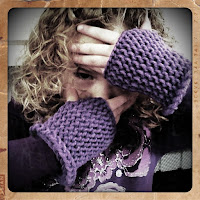
Increase stitches add to the width of a finished knitting project by
increasing the number of stitches in a row. Decrease stitches reduce
with width of the knit by making fewer stitches in the row. In knitting,
these techniques of increasing and decreasing stitches are used to
change shape, such as adding arms to a sweater. Projects requiring
increase and decrease stitches can be done on a Knifty Knitter knitting
loom by following a few simple steps.
Increase Stitch on the Knifty Knitter Loom
Increase stitches are used to add width, or flare to any knit project.
- Begin
the project as close to the center of the loom as possible. This leaves
room on both sides of the row to increase width equally.
- When
the end of the row is reached, rather than turning and knitting off back
across the row, use the yarn to wrap an additional peg.
- Continue wrapping until the row has been increased by the number of stitches desired.
- Continue knitting off back across the row.
Decrease Stitch on the Knifty Knitter Loom
Decrease stitches may be used to taper a waste line of a sweater, or narrow the wrist of a knitted arm.
- When
arriving at the row that is to be decreased, take the loop on the last
peg of the row and unhook it. Place it on the previous peg in the
row.Adding it to the previous peg, rather than simply dropping the
stitch, prevents the finished knit from unraveling.
- Repeat the step above until all the stitches that need decreased in the row have been removed.
- When knitting off, knit off all the additional loops that have been placed on the end peg of the row, as one loop.
When
creating increase and decrease stitches, the knit will stay
symmetrical, or the same on both sides, if the same number of stitches
are added or removed from each end. For example, when decreasing a row
by 6 stitches, 3 stitches should be taken from each end of the row to
keep the work balanced.When working with an odd number that
must be increased, or decreased, for a row of knitting stitches, try to
alternate the end of the row that gets the most increases or decreases.
For example, if you are decreasing 5 stitches from a Knifty Knitter row
take 3 from the left and 2 from the right side of the row. In the next
row, if more stitches need to be decreased, and the total number of
stitches removed is an odd number, take the extra stitch from the right
side rather than the left.


















